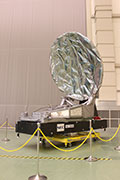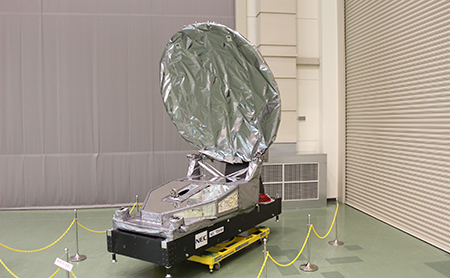About Earth Cloud Aerosol and Radiation Explorer (EarthCARE)
 |
Helping to improve predictions for changes in weatherEarthCARE is an earth observation satellite that Japan and Europe have been jointly developing. Using its four sensors (Cloud Profiling Radar, Backscatter Lidar, Multi-Spectral Imager and Broadband Radiometer), clouds and aerosols (small particles like dust and dirt that exist in the earth's atmosphere) will be observed on a global scale to improve the accuracy of climate change predictions. Climate change predictions are carried out by simulating the climate on computers. The accuracy of these simulations essentially depends on how accurate the data is portrayed from natural phenomena. However, as all natural phenomena related to climate changes are not yet understood, current predictions are sometimes unreliable. The biggest cause of this is said to be the effects from clouds and aerosols in radiation balance of the Earth's atmosphere. |
|---|
With the EarthCARE mission, observations will be carried out on the distribution of cloud particles and aerosols in a vertical direction and speed measurements performed on cloud particles ascending and descending. These have never previously been thoroughly observed. Through this, the mechanism of radiation balance in interaction between clouds and aerosols can be solved and improvements in climate change predictions are expected.
Project Topics
indexCloud Profiling Radar (CPR) engineering model

|
On Nov. 27, JAXA revealed to the media at the Tsukuba Space Center an engineering model* of the Cloud Profiling Radar (CPR), which will be aboard the Earth Cloud Aerosol and Radiation Explorer (Earth CARE).The CPR is a sensor to observe cloud distribution by emitting radiation to the ground and receiving its reflection wave. It is under development by JAXA in cooperation with the National Institute of Information and Communications Technology (NICT). *An engineering model is manufactured in alm... |
|---|
Press Release
index-
- Jun. 27, 2024 (11:00) [release]
- First images from Cloud Profiling Radar (CPR) onboard Earth Cloud Aerosol and Radiation Explorer (EarthCARE) "Hakuryu"
Characteristics of Earth Cloud Aerosol and Radiation Explorer (EarthCARE)
World's First On-board Cloud Profiling Radar (CPR) with Doppler Speed Sensor aboard a Satellite
|
In cooperation with the National Institute of Information and Communications Technology (NICT), JAXA is responsible for the development of the Cloud Profiling Radar (CPR), which will be the world's first W-band (94GHz) Doppler radar aboard a satellite. The CPR transmits millimeter-waves toward the earth from the satellite's orbit and receives radio waves scattered by the cloud particles. Using the largest antenna ever made, the CPR can make observations with sensitivity ten times higher than current cloud radars aboard satellites by transmitting a large amount of electricity. In addition, the CPR is the first millimeter-wave radar aboard a satellite to have Doppler speed sensor functions. Through this function, we can understand not only the vertical structure of clouds, but also the ascending and descending movement of clouds. |

|
|---|
Contents

- Aug. 6, 2008
- To Preserve Our Earth